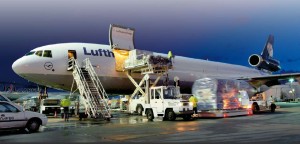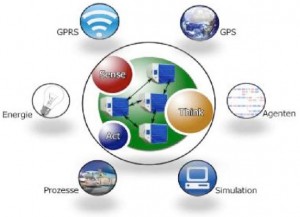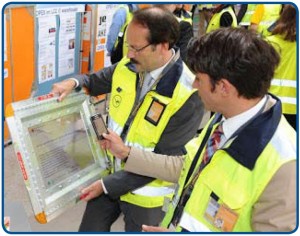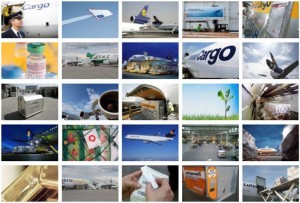Niko Hossain is Senior Manager of Global Handling Management with Lufthansa Cargo. His expertise and knowledge cover logistics, RFID project management of ICT innovations in supply chain management. Previously he was a project manager and research scientist at Fraunhofer IML Institute, which advises companies of all sizes and industries in matters relating to material flow and logistics. Before joining Fraunhofer, Niko Hossain was Director at Centro IBERLog.
An overview of emerging technologies in the air freight Industry with particular reference to the European logistics market
 Lufthansa Cargo ranks among the world’s leading cargo carriers. In the 2011 business year, the airline transported around 1.9 million tons of freight and mail and sold 9.5 billion revenue ton-kilometers. The Company focuses on the airport-to-airport business and serves more than 300 destinations in some 100 countries with its own fleet of freighters, the belly capacities of passenger aircraft operated by Lufthansa and Austrian Airlines, and an extensive road feeder service network. The bulk of the cargo business is routed through Frankfurt Airport. The company’s other hubs are in Munich, Leipzig-Halle and Vienna. Lufthansa Cargo is allied with other cargo carriers and companies affiliated to the freight business, which enhance one another’s products, services and network in the Lufthansa Cargo Group. Innovative logistics is therefore a major drive for the company’s business, especially in the face of competition form carriers in other parts of the world.
Lufthansa Cargo ranks among the world’s leading cargo carriers. In the 2011 business year, the airline transported around 1.9 million tons of freight and mail and sold 9.5 billion revenue ton-kilometers. The Company focuses on the airport-to-airport business and serves more than 300 destinations in some 100 countries with its own fleet of freighters, the belly capacities of passenger aircraft operated by Lufthansa and Austrian Airlines, and an extensive road feeder service network. The bulk of the cargo business is routed through Frankfurt Airport. The company’s other hubs are in Munich, Leipzig-Halle and Vienna. Lufthansa Cargo is allied with other cargo carriers and companies affiliated to the freight business, which enhance one another’s products, services and network in the Lufthansa Cargo Group. Innovative logistics is therefore a major drive for the company’s business, especially in the face of competition form carriers in other parts of the world.
ID People spoke to Niko Hossain, Senior Manager of Global Handling Management with Lufthansa Cargo on the industrial need of auto ID technology involvement in Europe to withstand the challenges of global competition.
What are the varieties and levels of air cargo today that require innovative logistics solutions particularly cargo with special requirements?
In order to set the scene, in Lufthansa alone, every 25 minutes a MD11/ B777 of Lufthansa Cargo Group takes off or lands. Examples of airfreight logistics within one year where efficient logistics needs are paramount include the air transport with Lufthansa Cargo of 80 million ornamental fishes, approximately 26,000 tons of fresh fruits, 20,000 tons of flowers and plants and more than 2,000 horses and 300 tons of fishing worms. Complementing this, more than 6,000 cameras worldwide kept the shipments under surveillance – also protecting 5,000 tons of valuable cargo flown over 12 months.
How does the logistics business Central Europe stack up against competition from other regions where global carriers are having an impact?
 We state that Lufthansa Cargo Group is the leading European airfreight carrier, but five out of 10 top worldwide freight forwarders are based in Germany or neighboring countries. This translates into business and service at the main air freight logistics hubs concentrated in central Europe in Frankfurt (FRA), Paris (CDG), Amsterdam (AMS) and Luxembourg (LUX).
We state that Lufthansa Cargo Group is the leading European airfreight carrier, but five out of 10 top worldwide freight forwarders are based in Germany or neighboring countries. This translates into business and service at the main air freight logistics hubs concentrated in central Europe in Frankfurt (FRA), Paris (CDG), Amsterdam (AMS) and Luxembourg (LUX).
However, European carriers are increasingly challenged by carriers from the Middle East, Russia and China. As a result, European airlines are facing this competition with digitization and deployment of new technologies in order to strengthen their positions in the market.
As far as Lufthansa Cargo is concerned, the company identifies itself as a leading industry partner for technology & logistics projects with Frankfurt as the ‘natural’ air cargo mega hub of North Rhine-Westphalia. Airfreight logistics in Frankfurt is an integral part of high-tech R&D made by Fraunhofer IML and we are therefore committed to implementing high levels of innovation.
Which general technology trends are opening new opportunities in airfreight logistics?
 Technology usage in terms of auto ID and the Internet of things is a specific area of development and one which we are embracing in the drive to become an industry leader in digitization.
Technology usage in terms of auto ID and the Internet of things is a specific area of development and one which we are embracing in the drive to become an industry leader in digitization.
Today, customers are hyperinformed and spend more time researching available solutions and services in order to make decisions, having also easy access to multiple sources of information.
Another challenge is the ability today to reach customer across multiple channels and this can result in overuse of devices. However, in this world of increasing interactivity, where everything is linked to the internet, there is an opportunity to create deeper customer engagement by offering more content and touch points.
E-commerce is becoming the de facto for commercial activity, buying and selling – whether it is a product or a service. Virtual supermarkets are emerging with posters enabling shopping online along with notifications, when passing a store, with a previously viewed item on offer.
This effective acceleration of everything further increases mobility, speed, coverage and use of mobile Internet resulting in viral transmission through the ‘Internet in your pocket’. This level of increased mobile functionality is also being aggregated in subtler ways as technology advances – such as translation through speech recognition.
In terms of R&D, what specific projects are underway or in place?
 The development of intelligent airfreight containers for integration in existing air cargo IT-systems is one major area. The Project DyCo- Net, or Dynamic Container Network, is being developed and introduced the intelligent airfreight container of the future. It operates with a multi-agent system for global autonomous network control and ad-hoc networks for near-field communications. Energy-self-sufficient functioning using energy from the environment (vibration, heat, etc.) is also deployed allowing environmental data to be captured via sensors enabling telematics functions.
The development of intelligent airfreight containers for integration in existing air cargo IT-systems is one major area. The Project DyCo- Net, or Dynamic Container Network, is being developed and introduced the intelligent airfreight container of the future. It operates with a multi-agent system for global autonomous network control and ad-hoc networks for near-field communications. Energy-self-sufficient functioning using energy from the environment (vibration, heat, etc.) is also deployed allowing environmental data to be captured via sensors enabling telematics functions.
We are also creating added value through cluster cooperation – a research project focusing on miniaturization and the development of miniaturized generators/ devices. Cutting edge-sensor technology is being introduced for enriched shipment- and ULD- data through the use of RFID and auto ID-technology. This allows for synchronized and automated streams of data and objects in real-time, bringing global and decentralized network steering.
How are Internet of Things concepts being applied within the airfreight industry?
A joint project involving Fraunhofer IML, ‘SMARTi’ is of special interest. Euro pallets move in this pilot circling the pallet services to manufacturers in the trade, and back. Nearly 500 of these charge carriers are already in use, and in each of their ways, the researchers have control over SMARTi-view, a central web-based information platform. It is a unique, intelligent carrier, whereby each pallet is identified by a label consisting of RFID tags and barcode, and clearly identifiable.
By communicating with each other and with existing systems the SMARTi pallets can interact between themselves and be routed over the logistics network. Fraunhofer IML continues to work with. Lufthansa Cargo to expand these capabilities and launch other successful collaborations.
Modern Unit Load Device systems are another cornerstone of the transport and Information Interface. Load carriers represent one of the most important resource in logistics. The entire economic power of logistics is based on the use of pallets, boxes and containers and their value amounts to billions of Euros in Germany alone. Combining them with radio frequency based technologies and the concept of the Internet of Things, as well as with modern material flow techniques, will result in unprecedented flexible and service-oriented logistic systems.
Partners from different branches are working together to revolutionize intelligent load carriers and to setup guidelines and standards in this top cluster project. By integrating additional information and intelligence on the object, a new philosophy of logistic organization will be developed. This will have radically innovative effects on everyone who benefits from logistic services.
